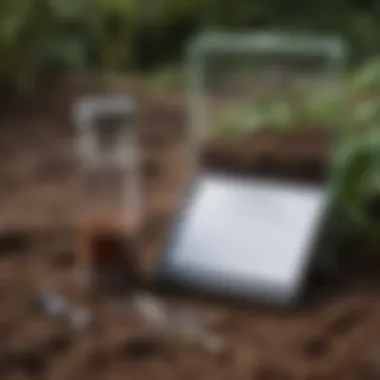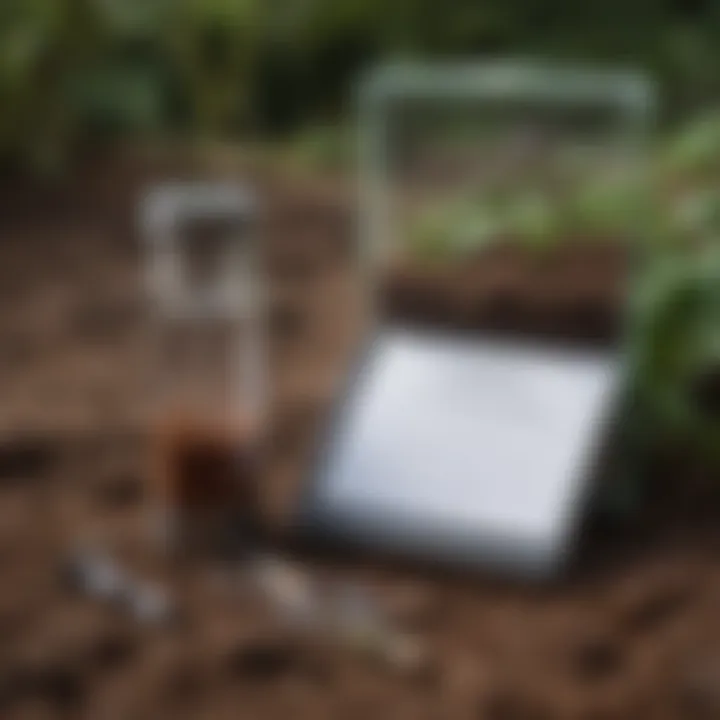Optimal Timing for Liming Your Lawn


Intro
Lime is an essential component for maintaining healthy soil and promoting robust grass growth. For homeowners, understanding when to lime the lawn is crucial for achieving the best possible lawn health. Liming not only affects pH levels but also influences nutrient availability in the soil. An optimal pH level supports the proper function of soil microbes, which are necessary for nutrient breakdown and absorption. Without appropriate liming practices, a lawn can suffer from poor growth, weed problems, and decreased resilience against pests.
Seasonal changes can significantly impact the effectiveness of liming. The timing of liming applications should align with specific periods in the growing season. Additionally, geographical factors play a role in determining when and how much lime is needed. New lawns and established lawns have different liming requirements, and understanding these distinctions is fundamental for effective lawn care.
In this comprehensive guide, we will explore the best times to lime, delve into soil testing practices, and discuss the effects of seasonal changes on soil pH. We will also provide insights tailored to your specific geographical area, equipping you with the knowledge to improve your lawn's health through effective liming strategies.
Prelims to Lawn Liming
Lawn liming is an essential aspect of lawn care that many homeowners overlook. It involves applying lime to the soil, which can have significant advantages for grass health. Understanding the role of lime in maintaining a healthy lawn ecosystem can improve overall performance and appearance. This practice can impact soil pH levels, nutrient availability, and overall soil quality, making it a noteworthy consideration for anyone invested in lawn aesthetics.
Lime itself is a soil amendment, and its application can help create a more hospitable environment for grass. When soil pH is out of balance, it may inhibit the ability of plants to absorb essential nutrients. Thus, knowing when and how to lime can have long-lasting benefits.
Understanding Lawn Liming
Lawn liming involves spreading powdered or granulated lime on your yard. There are two main types of lime used in lawn care: calcitic lime and dolomitic lime. Each type improves soil pH, but they also offer distinct benefits regarding the nutrients they provide.
Calcitic lime primarily raises soil pH and adds calcium, essential for plant development. Dolomitic lime serves a dual purpose: it can correct pH and replenish both calcium and magnesium levels in the soil. Knowing which type to use will depend on soil conditions and the specific deficiencies present in your lawn.
The process usually requires a soil test. This test will assess existing pH levels and inform whether your lawn will benefit from liming. Such assessments lead to more tailored lawn care solutions, better resource allocation, and ultimately, a healthier, greener lawn.
Importance of Soil pH
Soil pH is a crucial factor influencing plant health. Most grasses thrive in a pH range of 6.0 to 7.0, which is considered neutral. When soil pH dips below or rises above this range, nutrient availability decreases. This condition can lead to various problems, including poor growth and susceptibility to disease.
Maintaining the correct pH allows vital nutrients like nitrogen, phosphorus, and potassium to be accessible to grass roots. Liming the lawn is an effective strategy to adjust these levels. Therefore, understanding soil pH should be a priority for anyone committed to cultivating a lush green space.
A well-managed lawn is not just about regular mowing or fertilizing; it's about feeding the soil to grow rich, vibrant grass.
In summary, comprehending the importance of lawn liming and its relationship with soil pH underlines the need for this practice within effective lawn care. Through careful considerations of soil conditions and the strategic application of lime, homeowners can expect remarkable improvements in their lawns.
Determining the Need for Liming
Understanding when to lime your lawn is crucial for maintaining healthy grass. Liming can adjust soil pH, making nutrients more available to plants. Knowing if your lawn needs liming helps you avoid wasting time and resources. It ensures your efforts lead to a vibrant, lush lawn. This section examines how to determine the need for liming, focusing on practical steps that every homeowner can take.
Conducting a Soil Test
To start, conducting a soil test is the foundation of effective lawn care. This process involves collecting soil samples from various parts of your lawn. It's important to mix these samples for a representative picture of your soil’s condition. Many local agricultural extensions offer soil testing services, making it easy for homeowners to get detailed analysis.
The test results will show the pH level of your soil, which can indicate the need for lime. It's recommended to perform this test every couple of years or when you notice poor lawn performance. Specific testing kits can also be purchased, allowing for quick assessments at home. When testing, use clean tools to avoid contamination, and follow the instructions carefully for the best results.
Interpreting Soil Test Results
Once you receive the soil test results, understanding them is the next step. These results typically include information about pH levels, nutrients available in the soil, and potential deficiencies.
- pH Levels: Ideally, the pH for most lawns should range from 6.0 to 7.0. A pH below 6.0 indicates soil acidity, which may mean that liming will help. Conversely, a pH above 7.0 suggests alkaline soil, which might require other adjustments.
- Nutrient Levels: The test results will also inform you about key nutrients like phosphorus, potassium, and nitrogen. If your soil lacks essential nutrients, liming alone will not resolve these issues.
"A soil test is a valuable tool that guides your lawn care practices for optimal growth."
In summary, conducting a soil test and interpreting the results are vital steps in determining if and when to lime. By understanding your soil better, you can make informed decisions that enhance the health of your lawn.


Identifying the Best Time to Lime
Determining the appropriate timing for liming your lawn is pivotal for optimizing its health and vitality. Proper liming can significantly influence soil pH levels, affecting nutrient availability for grass. The timing of liming can promote optimal growth, enhance soil structure, and improve the overall resilience of your lawn. Understanding the seasonal trends and environmental conditions is necessary to make informed decisions. Assessing these factors helps ensure that the liming process aligns with your lawn's specific needs.
Seasonal Considerations
In deciding on when to lime, seasonal aspects must be considered given their impact on the soil and grass. The two primary seasons to consider are spring and fall, each presenting unique benefits.
Spring Liming Strategy
Spring liming is often recommended due to its alignment with the growing season. As temperatures warm, grass begins to grow actively. Applying lime at this time can facilitate improved soil nutrient absorption, leading to vibrant top growth. The essential characteristic of spring liming is its timing with grass regrowth, ensuring that any resulting changes in soil pH are taken advantage of when plants need them most.
One unique feature of spring liming is that it can help mitigate any winter or early spring soil acidity issues, creating a foundation for healthy growth. However, a disadvantage may be that soil moisture levels can still be variable during early spring, which may affect the lime dissolution process.
Fall Liming Benefits
Fall liming also is very beneficial. During this period, soil temperatures are still warm, which allows the lime to take effect before winter. This timing allows the lime to be absorbed into the soil gradually, preparing it for a healthy spring. One key characteristic of fall liming is that it aligns with the natural cycle of nutrient uptake in most grasses. As grass slows its growth for winter, liming in the fall can encourage improved soil conditions for the next growing season.
Additionally, fall liming can help with soil erosion prevention by strengthening the root systems, making it a popular choice among homeowners. However, the unique feature of fall liming is that it may not provide immediate visible benefits until the following spring, which can be a disadvantage for those seeking quick results.
Optimal Weather Conditions
Choosing the right weather conditions is essential for effective liming. Various factors can contribute to how well the lime integrates into the soil.
Humidity and Soil Moisture
Humidity levels and soil moisture greatly influence the lime's effectiveness. Optimal humidity ensures that soil moisture levels are adequate which aids in the lime reacting with soil particles effectively. The primary characteristic of this condition is its role in dissolution, as liming materials need moisture to break down and alter pH levels effectively.
When humidity is too low, lime may not react well; this can limit its benefits. However, too much moisture can wash away the lime before it can be fully integrated, presenting unique challenges.
Temperature Factors
Temperature is another crucial factor in determining the timing of liming. Typically, moderate temperatures between 50°F and 70°F are ideal for liming processes, ensuring that soil microbes remain active in processing nutrients. This characteristic underlies the responsiveness of grass to nutrient amendments.
Exposure to extremes, either high or low, can hinder the effectiveness of lime application. For example, applying lime during a heatwave might lead to rapid evaporation of moisture needed for chemical reactions in the soil, reducing its potential effectiveness.
Geographical Considerations
Understanding geographical considerations is crucial in determining the best time to lime a lawn. Each region in the United States has unique climate conditions, soil types, and growth patterns that affect the timing and application of lime. These factors can significantly influence the soil pH levels and overall health of the lawn.
Different areas experience variations in temperature and precipitation, which can impact the effectiveness of liming. Therefore, being aware of your local environment is essential when planning to lime your lawn. Let's explore how regional climate impacts the liming process across different parts of the country.
Regional Climate Impacts
Northeast U.S. Guidelines
In the Northeast U.S., the guidelines for liming focus on the cold climate, where winters might be harsh and summers can be humid. Lime should be applied in early spring or late fall. This timing ensures that the pH levels can balance when temperatures are mild. The key characteristic of this approach is that it aligns with the growth cycles of cool-season grasses that are prevalent in this area.
The unique feature of this region is its high rainfall, which can lead to soil acidity over time. Applying lime at the right seasons can counteract this phenomenon effectively. However, homeowners should be cautious of applying too late in the fall as the ground may freeze, affecting the lime's ability to work properly.
Southeast U.S. Considerations
In the Southeast, the warmer climate presents a different set of challenges. Soil in this region often becomes acidic more quickly due to excessive rainfall and high humidity. The best time to lime is typically late winter to early spring or throughout the fall months. This timing allows for optimal soil absorption during the growing seasons.


A notable characteristic of the Southeast U.S. is its diverse range of grass types, requiring tailored liming practices. Homeowners can benefit from this strategy, as it supports maintaining healthy acidic levels, promoting vibrant turf growth. However, care must be taken during heavy rains as runoff can wash away applied lime, diminishing its effectiveness.
Midwest Timing Approaches
When discussing Midwest timing approaches, there is a focus on the temperate climate that experiences both warm and cold seasons. It is recommended to apply lime in late summer or early fall. Cool-season grasses are dominant, and this timing matches their growth requirements, allowing them to benefit from the liming process before the winter.
A key aspect of this approach is the recognition of snow cover in winter, which can help in the gradual release of lime into the soil. However, the disadvantage lies in the variability of weather conditions, which can lead to uncertain outcomes in lime effectiveness. Homeowners should monitor their local weather patterns closely.
Western U.S. Adaptations
In the Western U.S., climatic variations significantly influence the liming process. Regions like California have different requirements compared to the mountainous areas of Colorado. Generally, late fall or spring is considered the optimal time for liming in this area. The drier conditions in many Western states make it vital to apply lime when there's enough moisture to facilitate absorption.
The unique feature of this region is its varied elevation and climate zones. Homeowners may need to adapt their liming strategies accordingly. For instance, higher elevations may call for late spring applications, while lower valleys might see benefits from fall liming.
In summary, understanding geographical considerations is essential in determining the right liming strategy. Each region presents its own challenges and benefits, making it imperative that homeowners pay attention to local climate conditions. This adaptability ensures a healthier lawn, ultimately supporting robust soil health.
Application Techniques for Liming
Application techniques for liming are critical for achieving optimal results in lawn health. Proper application ensures that the lime interacts effectively with the soil, leading to improved pH levels and nutrient availability. Understanding these techniques can aid homeowners in making informed decisions, ultimately enhancing their lawn care practices.
Choosing the Right Lime
Choosing the right lime is an essential first step in the liming process. Homeowners must understand the types of lime available and how each can affect soil pH and overall lawn health.
Calcitic Lime
Calcitic lime is primarily composed of calcium carbonate. Its main characteristic is the high calcium content, which is essential for plant growth. By applying calcitic lime, homeowners can increase calcium levels in the soil, benefiting the overall health of the lawn. This type of lime is particularly effective if the soil has a deficiency in calcium but does not need magnesium.
However, while calcitic lime is beneficial, it may not be as effective in soils that also require magnesium supplementation. Homeowners should consider their soil test results before choosing this option.
Dolomitic Lime
Dolomitic lime contains calcium carbonate as well as magnesium carbonate. This combination makes it a good choice for lawns where magnesium levels are low. Dolomitic lime can be a more balanced approach for amending soil, as it addresses both calcium and magnesium deficiencies.
Its key feature is its dual action, promoting healthier grass growth by providing essential nutrients. However, for soils already rich in magnesium, using dolomitic lime can lead to excessive magnesium levels, which can adversely affect certain grass types. Knowing the soil's nutrient composition is crucial.
Effective Application Methods
Once the right lime is selected, homeowners need to focus on the application methods to get the best results.
Broadcasting Techniques
Broadcasting techniques involve spreading lime uniformly across the lawn. This method is popular because it allows for even distribution, which is essential for effective soil amendment. Using a broadcast spreader ensures that the lime reaches all areas of the lawn.
The main advantage of broadcasting is its simplicity and efficiency. However, care must be taken to avoid over-application, which can lead to nutrient imbalances or burn the grass. Homeowners must calibrate their spreaders according to the manufacturer's recommendations.
Spreading Equipment Options
There are various spreading equipment options available, ranging from manual to motorized spreaders. Manual spreaders are suitable for small areas, while larger properties may benefit from tow-behind or self-propelled spreaders. The type of spreading equipment used can significantly impact how well the lime is applied and how evenly it is distributed.
A key characteristic of these machines is their ability to provide consistent coverage, reducing the risk of uneven application. However, the initial investment in quality spreading equipment may be a consideration for homeowners. It’s also important to maintain the equipment to ensure longevity and effectiveness.


"Proper application techniques can enhance the liming process, leading to healthier lawns and gardens."
Post-Liming Care
Post-liming care is a crucial aspect of maintaining a healthy lawn. After applying lime, homeowners must understand how to monitor and enhance the effects of liming. Proper post-liming practices can significantly influence the success of the liming process, ensuring improved soil pH and healthier grass.
Monitoring Soil pH Changes
After liming, it is important to regularly monitor the soil pH changes. The application of lime aims to raise the pH of the soil, making it less acidic. To achieve this, you should conduct soil tests at intervals after liming. Typically, testing can be done every few months or seasonally. It's essential to take samples from several areas of the lawn for an accurate reading. The primary aim here is to ensure that the pH is moving towards the optimal range, generally between 6.0 and 7.0 for most grass types. If results show that the pH is still too low, additional liming may be necessary. Regular monitoring can help you keep track of any changes and adjust your practices accordingly.
Enhancing Lawn Health After Liming
After liming, it is crucial to enhance your lawn health to maximize the benefits. This can be achieved through proper fertilization and appropriate watering practices.
Fertilization Techniques
Fertilization is an essential step in maintaining lawn health post-liming. The key characteristic of good fertilization is its ability to provide the necessary nutrients that grass needs for growth. When the soil pH is corrected through liming, nutrients become more available to plants, making fertilization more effective. Selecting a fertilizer that matches the needs of your grass type is a beneficial choice. For example, a balanced fertilizer with equal parts nitrogen, phosphorus, and potassium works well for many lawns. This balanced approach ensures that all nutrients are accessible for the grass, promoting healthy growth. However, be cautious not to over-fertilize, as this can lead to nutrient runoff and other environmental issues.
Watering Practices
Effective watering practices are also vital after liming. Proper watering allows the lime to penetrate the soil and integrate well. A key characteristic of these practices is the frequency and depth of watering. Deep and infrequent watering is generally preferable, as it encourages deep root growth. It is recommended to water your lawn thoroughly after liming but avoid doing so immediately after the application. This allows the lime time to start adjusting the soil pH before introducing more moisture. However, ensuring the soil doesn't dry out is crucial. Lack of moisture can impede the effectiveness of the lime application and adversely affect root systems.
"Proper post-liming care directly impacts the health and vitality of your lawn."
Challenges and Misconceptions
Lawn care can be muddled with various challenges and misconceptions that can lead to inadequate practices. This section aims to clarify these issues to ensure homeowners approach liming their lawns with confidence. By addressing common mistakes and prevalent myths, we can create a clearer understanding of the liming process and its significance in promoting a healthy lawn.
Common Mistakes in Liming
One of the most critical aspects of liming is timing. Many homeowners fail to recognize the importance of conducting a soil test before applying lime. They may assume that liming is necessary every season, but this is not true. Applying it without testing can potentially lead to over-liming, which can harm the lawn. When lime is added unnecessarily, it can elevate pH levels too much, resulting in nutrient deficiencies.
Another mistake is neglecting to follow manufacturer recommendations on application rates. Each type of lime has specific guidelines based on its composition. For example, calcitic lime provides calcium while dolomitic lime offers both calcium and magnesium. Miscalculating the amount needed can diminish the effectiveness of the treatment.
Moreover, some homeowners might spread lime too close to the grass, believing it will maximize its benefits. This can actually result in burning the grass. It is crucial to apply the lime evenly across the surface and allow it to settle into the soil. Understanding these common errors can prevent disappointing outcomes and promote better lawn health.
Addressing Myths About Lawn Care
Lawn care is laden with myths that often misguide homeowners. One prevalent myth is that liming is only beneficial in the spring. While spring liming has its advantages, particularly for established lawns, fall liming is equally important. It allows lime to integrate into the soil, preparing it for the next growing season.
People sometimes believe that liming alone can resolve all soil issues. In reality, it works best in conjunction with other soil care practices. Fertilization, aeration, and regular watering are all fundamental to maintain a robust lawn. Liming is just one piece of the puzzle, improving soil pH and nutrient availability, but not replacing other crucial factors.
Another misconception is that only specific grass types require liming. While certain grasses thrive in acidic conditions, most lawns benefit from a balanced pH. It's essential to understand the needs of your grass variety, so consider doing a soil analysis.
"Understanding the role of liming in a holistic lawn care strategy can lead to more vibrant and healthy grass."
Culmination
In the context of lawn care, the importance of liming should not be underestimated. This final section emphasizes the cumulative insights gathered throughout this article, highlighting why timely and appropriate liming is essential for maintaining a healthy lawn. The practice of liming addresses soil acidity and enhances nutrient availability, both of which are crucial for robust grass growth. Here, we summarize the key takeaways that every homeowner should keep in mind when considering liming.
Recap of Key Points
- Soil pH Matters: A balanced soil pH level is vital for effective nutrient uptake by grass. Liming raises the pH and promotes a more fertile soil environment.
- Timing is Key: Applying lime during optimal seasons, specifically early spring or fall, allows the treatments to break down effectively and integrate with the soil.
- Soil Testing: Regular soil testing is necessary to understand the initial pH level and determine the specific amount of lime needed. This practice guides homeowners in avoiding the pitfalls of over-application.
- Regional Considerations: Recognizing geographical differences in climate and soil types can significantly impact the timing and method of liming.
- Post-Liming Care: Following liming, appropriate fertilization and watering practices can enhance the benefits and ensure the lawn remains healthy.
Final Thoughts on Lawn Liming
Lawn liming is not merely a process; it is a fundamental practice that aids in creating a vibrant and thriving outdoor space. Homeowners should consider liming as part of a holistic lawn care routine that also includes regular maintenance and care. By integrating lime applications into their schedule, individuals are committing to improved lawn aesthetics and health.
"A healthy lawn is often a reflection of its soil condition; liming plays a pivotal role in achieving this balance."















